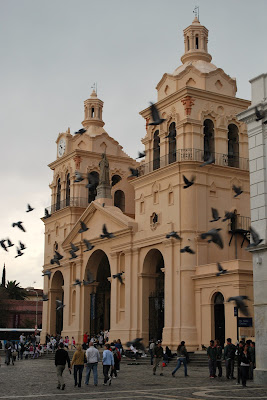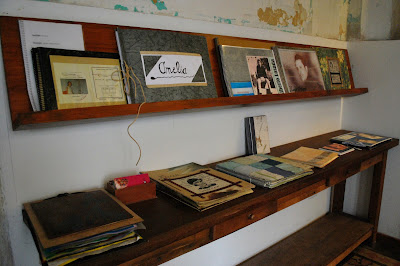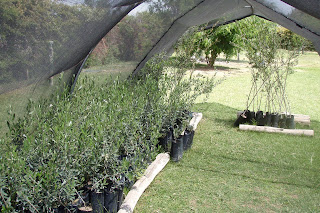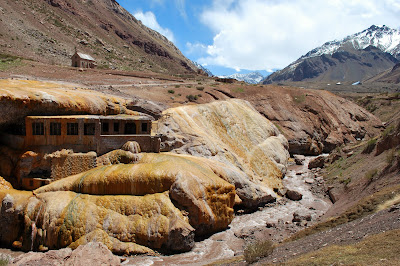Our blog got away on us again! We were unexpectedly without internet for a few days while we were off galavanting in remote villages in the Argentinian Andes, but safely in Santiago this blog post is picture-packed thanks to the speediest internet we've had yet.
We left you in Tucuman, where we took a night bus to Córdoba. Next to Bolivan night buses it was a luxury, although luxurious or not it's a coin toss whether you get a good nights sleep; Alex had a dreadful sleep, and Lisa slept like a baby. We checked into Hostal Palenque early in the morning, which was a cute little joint.
Córdoba is a city rich with culture. On our first day in Córdoba we paid a visit to the Museo de la Memoria. Set in a former detention/torture facility, it was a somber documentation of the Dirty War. One of the most interesting parts of the museum was reading the documentary scrapbooks assembled by the families of "disapeared" political prisoners.
The best part was meeting our to-be tour guide, Tom, at the museum. He seemed very savvy, and Lisa began asking him a few questions about the exhibit, which led to an hour-long enlightening discussion of Argentinian politics. After the museum Tom offered to show us around the city. We visisted La Cañada (the very polluted canal/stream running through the center of the city), the shopping streets, plazas, universities, judicial buildings and the like. All the while, Tom gave us a fascinating history lesson on Córdoba and Argentina. It was so great to have an enthusiastic local (who we might add spoke impecable english) show us around the city.
In keeping with out attempts to try ALL local culinary specialties, Tom directed us to a cute little place for lunch where we tried various regional empanadas and Locro, a interesting stew of maize and corn.
We loved the flowering purple trees (called Jacaranda) which were everywhere (you can see one of them in the bottom right corner of the picture below).
We took a day trip to Alta Gracia, a nearby town (population: 43,000), where the primary childhood residence of the family of Ernesto [Che] Guevara has been converted into a museum. Did you know Che Guevara had a medical degree? We didn't. (Although apparently he lost interest in the profession shortly after earning his professional degree.) Here is a peculiar photo from the museum showing Che and his fellow medical students, and a cadaver.
Here is Che's motorbike (his second one) and a map of his two cross-country motorcycle trips around South America.
After our day in Alta Gracias we met back up with Tom, who introduced us to the art of Mate drinking. In the evenings, local youngsters flock to the parks and town squares to socialize, drink mate and eat snacks (pastries or empanadas are typical, since locals don't eat dinner until at least 8p.m.). It is such a popular activity that we had to wander around a bit to even find a place to sit down.
One thing we've noticed in Argentina is that we no longer stick out much. Argentina is much more multi-cultural, and light skin is common. When the locals find out you are a foreigner, they are very curious, pleasant and helpful.
From Cordoba, we took another night bus to Mendoza, and met back up with Dewey. The three of us, and Koko, from Alabama, did a tour of vineyards in the area by bike. In Argentina, change is next to impossible to come by. Stores refuse to give change (they will round up if you don't have it), and the bus companies apparently have a monopoly on the stuff (which we heard they sell to the black market); see article 1 and article 2 on the issue if you are curious. Consequentially we couldn't catch a bus in Mendoza and had to pay for a cab to the vineyard region. We rented bikes from Mr. Hugo (pictured below); by far the coolest of the bike-renting bunch. He greeted us with a pitcher of red wine, which he generously offered both before and after our biking adventure.
First we visited the olive farm "A la Antigua", which also made chocolates, liquors, tapenades, conserves and balsamic vinegar (to name a few). We sampled all sorts of products, including absynthe. Our favorite was the green olive and garlic tapenade, which we bought a jar of. Very sadly, the jar came open during the bouncy ride in the bike basket down a gravel road, and we had tapenade all over the bike. We had a sad moment where we silently looked at each other and the tapenade and then scooped what we could of it from the bike basket back into the jar and pretended it never happened. (It tasted great, by the way.) This is the greenhouse that the olive plants are started in... we thought we'd take a picture as a subtle hint for our parents that we should look into the agricultural opportunity ;)
From the olive farm we peddled about 6km to Bodege Vina El Cerno, where we sampled some Malbec, Torrontes, a Cabernet Sauvignon Reserva and a Tempranillo (a new variety to us). They were definitely good wines, but nothing stood out to us. We also enjoyed a parrilla (BBQ meat) snack.
Our final stop of the day was Bodega Carinae. We intended to visit more wineries but we had such a pleasantly relaxing time at Carinae, in the company of the wonderful French owner, that we ran out of time to go any further. This was by far our favorite winery. Maybe we were swayed by the oh-so-friendly owners (and their dogs) and the wine we'd already consumed that day, but for some reason we just fell in love with it. We tried a few wines (the Malbec Rosado, 2009 Malbec, Cuvee Brigitte, Octans, Torrontes, the Malbec Gran Reserva, the Syrah Gran Reserva, and then because it was "the end of the day" the owner threw in a very expensive glass of the "prestige" for us to try as well), all for about $6.50CDN. We were pleasantly surprised by the Rosado, which we found very lovely despite not being Rose fans. Our favorite by far (hence the "five fingers" rating it earned) was the 2007 Syrah Gran Reserva. In our books, it outdid even the Prestige, although the last 3 wines we tried were all great wines, and noticeably better than others we've tried.
For the over-observant, we will mention that the prices in the poster below are in Argentinian Pesos, not American dollars. The Peso is about $4 to $1CDN, but of course the wines would sell for considerably more in Canada, since they aren't common imports.
We said goodbye to the owners and peddled onwards. We broke up the 10km return trip with a break at El Cerveceria (a micro-brewery). We tried Hormiga Roja ("Red Ant") beer and ate typical rice-puff-chip snack things (hard to explain).
We rode back to Mr. Hugo's to relax over some more red wine, with good company (and a cat). Mr. Hugo then kindly put us back on a bus back to Mendoza by paying with the change we didn't have.
We have no pictures from the following day, because we didn't really leave the hostel for two reasons; 1) Alex couldn't get out bed (it had nothing to do with the wine, we swear - just a stomach bug) and 2) a bizarre dust-storm/heat-wave rolled into Mendoza. It was nearly unbearable to go outside since it was about 38 degrees C, there was a dense "fog" of dust and pollen and the streets were littered with tree branches. Few locals even dared to go outside, and those who did wore face masks. Lisa ventured out for groceries and came back with very itchy and sore eyes. We were super excited to have a picnic this day (to enjoy all the gastronomic goodies that Mendoza had to offer), but post-poned things for later.
The next day we took a bus to nearby Uspallata; a small town in the mountains, where we enjoyed out picnic indoors because it happened to be snowing! We are officially back into lands of abundant good food. We had salami, brie, dried pears, cashews, our olive tapenade (from the story above), tea, olives, rustic bread, fresh fruit and pastellitos (a typical pastry dessert).
We stayed at Hostal Uspallata, 5km outside of the town of Uspallata. It was an adorable hostel with super friendly staff, and a warm living room with a wood stove and cold beer. Normally there was internet too, but the storm the previous day had knocked this out. There's not much going on is Uspallata, but the landscapes are gorgeous and the people are friendly.
The hostel was home to 5 dogs, one of whom (pictured below) was a nutcase. She desperately craved attention, and loved to chase rocks. She'd find a rock, bring it to you, and beg for you to throw it (rather than a stick). Can't be good for the teeth! Silly dog.
On day two in Uspallata we went for a casual 23km stroll into the surrounding hills in search of Cerro Colorado... which we never did find. It was a bit dissapointing, but the walk was enjoyable regardless, and to be fair, we have been a little bit spoiled by the views we've been seeing.
Alex and Dewey have a new favorite beer; Andes. It was well deserved after a day of walking. We also had some time to kill because the grocery store didn't open until 6p.m., so relaxed at a local cafe.
The next day we headed for Puente del Inca; two hours down the road, towards the Chilean border. Since we were essentially in the middle of nowhere, we hitched a ride on a passing bus.
The views from the bus were great.
Puente del Inca is a natural stone bridge across the Rio Mendoza. Underneath the bridge are the ruins of an old spa, stained yellow by the sulfurous thermal springs. The church in the background was the only building to survive a avalanche which wiped out the resort.
We walked to the nearby Parque Provincial Aconcagua, which was only a couple kilometers from Puente del Inca. Luckily for us, the park workers are currently on strike, so we avoided paying the $20CDN entrance fee. The park is home to the western hemisphere's highest summit (Aconcagua); 6962 meters above sea level. We hiked up the valley to where we could get a good view of the peak, but it was cloudly so we couldn't see the summit.
The wind up here always picks up in the afternoon, and it was particularly bothersome.
Here is a view of Puente del Inca from up the valley. The town has a permanent population of about 20. We stayed in another cute hostel; Hostel Nico (behind the Correo, across the train tracks). If you include the nearby military base the population jumps to 100. In the winter months, the town houses hundred of tourists for the nearby Los Penitentes ski resort.
Proof that they will try and sell anything to tourists (and that some tourists will buy just about anything). "Positive Energy Rocks", and bags of sand claiming to heal arthritis, headaches, etc...



































Great blog ladies. I'm going to see if I can find your "five finger rated" wine here in Calgary. Love MOM
ReplyDeleteStunning mountain photos. What side of the road do they drive on in Argentina - from your hitching hiking photo it looks like they drive on the left? The cycling photos are fun too. xoxo AR
ReplyDeleteGreat job! Thanks.
ReplyDelete